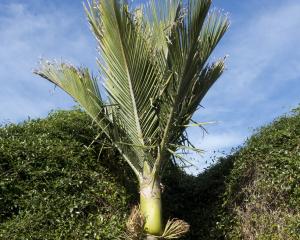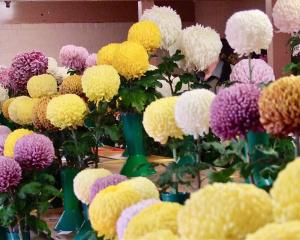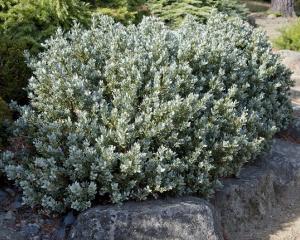A Welsh property is believed to be the oldest decorative garden in the United Kingdom. In her continuing garden history series, Gillian Vine reports on Aberglasney, in Wales.
Until the 17th century, British gardens were places for growing food and medicinal plants, with large properties including orchards, vineyards, dovecotes and ponds for raising fish.
Monks specialised in raising plants for healing and in manor houses, ladies took pride in their plots of medicinal herbs.
Some gardens were undoubtedly decorative, thanks to plants like roses, Madonna lilies and lavender, while the restorative effects of pleasure gardens were championed by the monks.
But overall, a plant had to be useful to be included.
Joseph James Atkin, head gardener at Aberglasney, in Carmarthenshire, southwest Wales, describes the property as "the first example I can find of a person displaying their wealth through a garden''.
It was created by the wealthy Bishop Anthony Rudd (c. 1548-1614), a Yorkshire-born bishop tipped to be Archbishop of Canterbury.
Unfortunately, he managed to offend Queen Elizabeth, killing any dreams of Lambeth Palace, and stayed in Wales.
Wales is an ancient land and Carmarthenshire is typical.
There is evidence of an Iron Age settlement in the area, perhaps as early as 800BC.
Aberglasney itself is a mere chick, with archaeological work suggesting it dates back to the 13th century.
Coins as early as AD1288 have been found in the Cloister Garden, whose walls are thought to have been erected not long before Bishop Rudd came on the scene in AD1600.
Like many old properties, Aberglasney has a chequered history.
In the 20th century, the estate was chopped up on several occasions, then vandalism, theft, neglect and the weather combined to such an extent that it seemed doomed.
The dismantling of the portico above the front door was the last straw.
It was to be auctioned by Christie's but could not be sold, as its removal from a listed building was an offence.
There was a prosecution and the associated publicity raised the property's profile, culminating in its 1995 sale to the Aberglasney Restoration Trust.
In the 4ha gardens, work has concentrated on saving what is salvageable, like the splendid collection of trees, introduced from North America after 1750.
By the time the trust was established, the American Garden was overgrown and dismal.
Now restored and renamed Bishop Rudd's Walk, it is a lovely area, full of magnolias, rowans and shrubs, which appreciate the high rainfall (3000mm annually) and slightly acid soil.
They are underplanted with primulas and hardy woodland groundcovers.
From the top of the walk, the church at Llanhathen, where the bishop is buried, can be seen.
Another restoration project was saving the yew tunnel, planted more than 300 years ago.
Whereas I appreciated the work involved in bringing this important historic feature back from near death, I found it a spooky spot and didn't want to linger.
Maybe if I had, I would have spotted the resident ghost, although I was told she was usually found inside the house, wandering around carrying a candle.
Now on the agenda are plans to restore the lower garden and add glasshouses.
The latter could help produce food for the café on site.
It is a matter of pride that "no plate goes out from the café without something from the garden'', Atkin said.
He has been at Aberglasney since 2010 and March is his favourite month, although the last week in April is "quite exciting'', when spring bulbs, notably tulips and narcissi, are a feature.
The numbers are staggering, with 40,000 bulbs planted annually.
However, Atkin considers that overall the best months to visit are May, June, July and September.
One of the attractions in summer is the rose garden, completed in 2014, at its best in June and July, as the roses are all old-fashioned varieties and do not repeat-flower.
Colours are very important to Atkin.
"We do try to keep it simple but the borders can be very, very complex,'' he said.
A hot garden, dominated by scarlet and orange, features stunning crocosmias in autumn, with varieties unavailable in New Zealand, such as deep red Hellfire and scarlet Red Bird, as well as a fine yellow, possibly Aurea.
Reinforcing the warm tones are lots of hot pokers, including a clump of rich golden Brimstone, while the area is cooled by a central pool.
In front of the house, in keeping with its Victorian facade, Atkin has planted flowers that would have been familiar in the latter half of the 19th century, such as dahlias.
There are modern varieties here for he believes the 19th-century gardeners would have chosen these more impressive plants had they been an option back then.
One aspect of Aberglasney's Victorian owners was bad.
"They ... bulldozed things.''
Only the gatehouse remains of what was an extensive wall.
Fortunately they left the cloisters intact.
The terrace walk around the top gives the visitor splendid views of the formal gardens, notably the Cloister Garden and the central walled area, once an orchard.
The latter was laid out by garden designer/historian Penelope Hobhouse and is loosely based on an old plan of concentric ovals contained in an oblong.
It "is heaving with tulips in spring'', Atkin said.
Beyond the Cloister Garden is a vegetable garden, perhaps more correctly a potager, as flowers mingle with edibles.
"We cut 600 to 1000 bunches of sweet peas a year and sell them in the shop,'' Atkin said.
Leading from it is a splendid arch of Sargent's apple (Malus sargentii).
As well as being decked with white flowers in spring, this crabapple has fine autumn foliage and small red-and-yellow fruit.
The influential Royal Horticultural Society has rated Aberglasney one of the top 10 formal gardens in the UK, the only Welsh garden on its list.
"It's quite an accolade,'' Atkin said.
And a well-deserved one.
● In Wales, Gillian Vine was the guest of Visit Wales (www.visitwales.com). She stayed at Llangoed Hall (www.llangoedhall.co.uk), a splendid country-house hotel in the Wye Valley, mid-Wales. Room rates, including breakfast, are from £130 ($NZ285.25) a night.
See it
Aberglasney Gardens, Llangathen, Carmarthenshire, Wales SA32 8QH are open every day except Christmas Day. Admission is £8 ($NZ17.55) an adult, £4 ($NZ8.78) for a child over 5 and £20 ($NZ43.88) for a group of two adults and two children. The shop is accessible to visitors without the need to pay admission to the garden.










